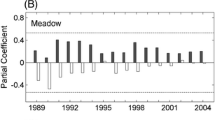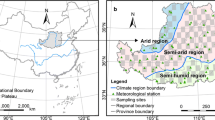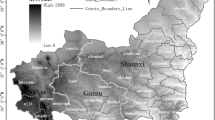Abstract
In recent years, many studies have focused on the changes of partial or single African ecosystems and the drivers of those changes. However, focusing only on partial or single ecosystems has limited the understanding of the relationships between the vegetation and climate changes in all of the African ecosystems. In this study, the temporal trends of the satellite-derived annual mean leaf area index (GLASS-LAI) were analyzed, and the inter-annual relationships were developed between the annual mean LAI and the climate variables (precipitation and temperature) for the time period ranging from 1982 to 2013. Additionally, this study applied seasonal curves and step-wise multiple regression methods to investigate the relationships between intra-annual LAI and climate changes. It was found that the GLASS-LAI over half of Africa had shown general significant greening or browning trends during the period from 1982 to 2013. From the results of inter-annual analysis, with mean annual precipitation lower than 600 mm, the greening of the savannas and grasslands in the Sahel was found to highly correspond with the increased precipitation. In contrast, the evergreen broadleaf forests in the Gulf of Guinea and Congo Basin showed strongly positive responses to the annual temperature when the mean annual temperature was below 25 °C. In regard to the intra-annual responses, the precipitation with 1-month lags was found to be helpful for the vegetation growth, with the exception of the evergreen broadleaf. The results of this research study indicated that the different land-covers in Africa had displayed clear differences in their annual trends during the examined 32-year period and had responded differently to the inter- and intra-annual climate drivers. This difference was evident by the characteristics of the vegetation covers and the geographic distributions. Therefore, further examinations of these differences can potentially improve the understanding of the land surface-atmosphere interactions among the different African ecosystems.







Similar content being viewed by others
References
Anyamba A, Small JL, Tucker CJ, Pak EW (2014) Thirty-two years of Sahelian zone growing season non-stationary NDVI3g patterns and trends. Remote Sens 6(4):3101–3122
Badreldin N, Sanchez-Azofeifa A (2015) Estimating forest biomass dynamics by integrating multi-temporal Landsat satellite images with ground and airborne LiDAR data in the Coal Valley Mine, Alberta, Canada. Remote Sens 7(3):2832–2849
Benesty J, Chen J, Huang Y, Cohen I (2009) Pearson correlation coefficient. Noise reduction in speech processing. Springer, Heidelberg, pp 1–4
Brando PM, Goetz SJ, Baccini A, Nepstad DC, Beck PS, Christman MC (2010) Seasonal and interannual variability of climate and vegetation indices across the Amazon. Proc Natl Acad Sci U S A 107:14685–14690
Camberlin P, Martiny N, Philippon N, Richard Y (2007) Determinants of the interannual relationships between remote sensed photosynthetic activity and rainfall in tropical Africa. Remote Sens Environ 106(2):199–216
Campo-Bescós MA, Muñoz-Carpena R, Southworth J, Zhu L, Waylen PR, Bunting E (2013) Combined spatial and temporal effects of environmental controls on long-term monthly NDVI in the southern Africa Savanna. Remote Sens 5(12):6513–6538
Carvalhais N, Forkel M, Khomik M, Bellarby J, Martin J, Migliavacca M, Mu M, Saatchi S, Santoro M, Thurner M, Ulrich W, Ahrens B, Beer C, Cescatti A, Randerson JT, Reichstein M (2014) Global covariation of carbon turnover times with climate in terrestrial ecosystems. Nature 514(7521):213–217
Chen T, De Jeu RM, Liu YY, Van der Werf GR, Dolman AJ (2014) Using satellite based soil moisture to quantify the water driven variability in NDVI: a case study over mainland Australia. Remote Sens Environ 140:330–338
de Jong R, de Bruin S, de Wit A, Schaepman ME, Dent DL (2011) Analysis of monotonic greening and browning trends from global NDVI time-series. Remote Sens Environ 115(2):692–702
Duveiller G, Hooker J, Cescatti A (2018) The mark of vegetation change on Earth’s surface energy balance. Nat Commun 9(1):679
Fang H, Jiang C, Li W, Wei S, Baret F, Chen JM, Pinty B (2013) Characterization and intercomparison of global moderate resolution leaf area index (LAI) products: analysis of climatologies and theoretical uncertainties. J Geophys Res Biogeosci 118(2):529–548
Fensholt R, Proud SR (2012) Evaluation of earth observation based global long term vegetation trends—comparing GIMMS and MODIS global NDVI time series. Remote Sens Environ 119:131–147
Fensholt R, Rasmussen K, Nielsen TT, Mbow C (2009) Evaluation of earth observation based long term vegetation trends—Intercomparing NDVI time series trend analysis consistency of Sahel from AVHRR GIMMS, Terra MODIS and SPOT VGT data. Remote Sens Environ 113(9):1886–1898
Fensholt R, Langanke T, Rasmussen K, Reenberg A, Prince SD, Tucker C, Scholes RJ, Le QB, Bondeau A, Eastman R, Epstein H, Gaughan AE, Hellden U, Mbow C, Olsson L, Paruelo J, Schweitzer C, Seaquist J, Wessels K (2012) Greenness in semi-arid areas across the globe 1981–2007—an earth observing satellite based analysis of trends and drivers. Remote Sens Environ 121:144–158
Fishwick S, Bastow ID (2011) Towards a better understanding of African topography: a review of passive-source seismic studies of the African crust and upper mantle. Geol Soc Lond Spec Publ 357(1):343–371
Foley JA, Coe MT, Scheffer M, Wang G (2003) Regime shifts in the Sahara and Sahel: interactions between ecological and climatic systems in northern Africa. Ecosystems 6(6):524–532
Forzieri G, Alkama R, Miralles DG, Cescatti A (2017) Satellites reveal contrasting responses of regional climate to the widespread greening of Earth(J). Science 356(6343):1180–1184
Gao Q, Schwartz MW, Zhu W, Wan Y, Qin X, Ma X, Liu S, Williamson MA, Peters CB, Li Y (2016) Changes in global grassland productivity during 1982 to 2011 attributable to climatic factors. Remote Sens 8(5):384
Herrmann SM, Anyamba A, Tucker CJ (2005) Recent trends in vegetation dynamics in the African Sahel and their relationship to climate. Glob Environ Chang 15(4):394–404
Heumann BW, Seaquist JW, Eklundh L, Jonsson P (2007) AVHRR derived phenological change in the Sahel and Soudan, Africa, 1982–2005. Remote Sens Environ 108(4):385–392
Huete AR, Liu HQ, Batchily K, Van Leeuwen W (1997) A comparison of vegetation indices over a global set of TM images for EOS-MODIS. Remote Sens Environ 59(3):440–451
Huete A, Didan K, Shimabokuro Y, Ferreira L, Rodriguez E (2000) Regional Amazon basin and global analyses of MODIS vegetation indices: Early results and comparisons with AVHRR, IGARSS 2000: IEEE 2000 International Geoscience and Remote Sensing Symposium, Vol I-VI, Proceedings: 536–538
IPCC (2007) IPCC Fourth Assessment Report: Climate Change 2007 (AR4). IPCC, Cambridge
Jamali S, Seaquist J, Eklundh L, Ardö J (2014) Automated mapping of vegetation trends with polynomials using NDVI imagery over the Sahel. Remote Sens Environ 141:79–89
Laporte NT, Stabach JA, Grosch R, Lin TS, Goetz SJ (2007) Expansion of industrial logging in Central Africa. Science 316(5830):1451–1451
Loveland TR, Reed BC, Brown JF, Ohlen DO, Zhu Z, Yang L, Merchant JW (2000) Development of a global land cover characteristics database and IGBP DISCover from 1 km AVHRR data. Int J Remote Sens 21(6–7):1303–1330
Malhi Y, Wright J (2004) Spatial patterns and recent trends in the climate of tropical rainforest regions. Proc R Soc Lond B 359(1443):311–329
Malhi, Y, Adu-Bredu, S, Asare, RA, Lewis, SL, Mayaux, P (2013) African rainforests: past, present and future. Philosophical transactions of the royal society B-Biological Sciences 368(1625):1–10
Martiny N, Camberlin P, Richard Y, Philippon N (2006) Compared regimes of NDVI and rainfall in semi-arid regions of Africa. Int J Remote Sens 27(23):5201–5223
Midgley GF, Aranibar JN, Mantlana KB, Macko S (2004) Photosynthetic and gas exchange characteristics of dominant woody plants on a moisture gradient in an African savanna. Glob Chang Biol 10(3):309–317
Monteith JL, Unsworth MH (1990) Principles of environmental physics. Edward Arnold, London
Nemani RR, Keeling CD, Hashimoto H, Jolly WM, Piper SC, Tucker CJ, Myneni RB, Running SW (2003) Climate-driven increases in global terrestrial net primary production from 1982 to 1999. Science 300(5625):1560–1563
Nyblade AA, Pollack HN, Jones DL, Podmore F, Mushayandebvu M (1990) Terrestrial heat flow in east and southern Africa. J Geophys Res 95:17371–17384
Pettorelli N, Vik JO, Mysterud A, Gaillard JM, Tucker CJ, Stenseth NC (2005) Using the satellite-derived NDVI to assess ecological responses to environmental change. Trends Ecol Evol 20(9):503–510
Philippon N, De Lapparent B, Gond V, Sèze G, Martiny N, Camberlin P, Cornu G, Morel B, Moron V, Bigot S, Brou T, Dubreuil V (2016) Analysis of the diurnal cycles for a better understanding of the mean annual cycle of forests greenness in Central Africa. Agric For Meteorol 223:81–94
Piao SL, Friedlingstein P, Ciais P, Zhou LM, Zhou L, Chen A (2006) Effect of climate and CO2 changes on the greening of the Northern Hemisphere over the past two decades. Geophys Res Lett 33(23):1–6
Piao SL, Wang X, Ciais P, Zhu B, Wang T, Liu J (2011) Changes in satellite-derived vegetation growth trend in temperate and boreal Eurasia from 1982 to 2006. Glob Chang Biol 17(10):3228–3239
Samanta A, Ganguly S, Hashimoto H, Devadiga S, Vermote E, Knyazikhin Y, Nemani RR, Myneni RB (2010) Amazon forests did not green-up during the 2005 drought. Geophys Res Lett 37(5):1–5
Sankaran M, Hanan NP, Scholes RJ, Devadiga S, Vermote E, Knyazikhin Y, Nemani RR, Myneni RB (2005) Determinants of woody cover in African savannas. Nature 438(7069):846–849
Traore AK, Ciais P, Vuichard N, MacBean N, Dardel C, Poulter B, Piao SL, Fisher JB, Viovy N, Jung M, Myneni R (2014) 1982–2010 trends of light use efficiency and inherent water use efficiency in African vegetation: sensitivity to climate and atmospheric CO2 concentrations. Remote Sens 6(9):8923–8944
van der Molen MK, Dolman AJ, Ciais P, Eglin T, Gobron N, Law BE, Meir P, Peters W, Phillips OL, Reichstein M, Chen T, Chen T, Dekker SC, Doubková M, Friedl MA, Jung M, van den Hurk BJJM, de Jeu RAM, Kruijt B, Ohta T, Rebel KT, Plummer S, Seneviratne SI, Sitch S, Teuling AJ, van der Werf GR, Wang G (2011) Drought and ecosystem carbon cycling. Agric For Meteorol 151(7):765–773
Von Storch H, Zwiers FW (2002) Statistical analysis in climate research. Cambridge University Press, Cambridge
Wang X, Piao SL, Ciais P, Friedlingstein P, Myneni RB, Cox P, Heimann M, Miller J, Peng S, Wang T, Yang H, Chen A (2014) A two-fold increase of carbon cycle sensitivity to tropical temperature variations. Nature 506(7487):212–215
Williams CA, Hanan NP, Neff JC, Scholes RJ, Berry JA, Denning AS, Baker DF (2007) Africa and the global carbon cycle. Carbon Balance Manag 2(1):3
Wu M, Schurgers G, Rummukainen M, Smith B, Samuelsson P, Jansson C, Siltberg J, May W (2016) Vegetation-climate feedbacks modulate rainfall patterns in Africa under future climate change. Earth Sys Dynam 7(3):627–647
Xiao Z, Liang S, Wang J, Chen P, Yin X, Zhang L, Song J (2014) Use of general regression neural networks for generating the GLASS leaf area index product from time-series MODIS surface reflectance. IEEE Transactions on Geoscience and Remote Sensing 52(1): 209–223
Xu L, Samanta A, Costa MH, Ganguly S, Nemani RR, Myneni RB (2011) Widespread decline in greenness of Amazonian vegetation due to the 2010 drought. Geophys Res Lett 38(7). https://doi.org/10.1029/2011GL046824
Zhou L, Tian Y, Myneni RB, Ciais P, Saatchi S, Liu YY, Piao SL, Chen HS, Vermote EF, Song CH, Hwang T (2014) Widespread decline of Congo rainforest greenness in the past decade. Nature 509(7498):86–90
Zhu Z, Bi J, Pan Y, Ganguly S, Anav A, Xu L, Samanta A, Piao SL, Nemani RR, Myneni RB (2013) data sets of vegetation leaf area index (LAI) 3g and fraction of photosynthetically active radiation (FPAR) 3g derived from global inventory modeling and mapping studies (GIMMS) normalized difference vegetation index (NDVI3g) for the period 1981 to. Remote Sens 5(2):927–948
Zhu Z, Piao SL, Myneni RB, Huang MT, Zeng ZZ, Canadell JG, Ciais P, Sitch S, Friedlingstein P, Arneth A, Cao CX, Cheng L, Kato E, Koven C, Li Y, Lian X, Liu YW, Liu RG, Mao JF, Pan YZ, Peng SS, Peñuelas J, Poulter B, Pugh TAM, Stocker DB, Viovy N, Wang XH, Wang YP, Xiao ZQ, Yang H, Zaehle S, Zeng N (2016) Greening of the Earth and its drivers. Nat Clim Chang 6:791–195
Acknowledgments
The authors would like to expand their expressions of sincere gratitude to the editor and anonymous reviewers who provided professional comments for this research study.
Funding
This study was financially supported by the National Natural Science Foundation of China (41471343).
Author information
Authors and Affiliations
Corresponding author
Ethics declarations
Conflict of interest
The authors declare that they have no conflict of interest.
Rights and permissions
About this article
Cite this article
Li, W., Du, J., Li, S. et al. The variation of vegetation productivity and its relationship to temperature and precipitation based on the GLASS-LAI of different African ecosystems from 1982 to 2013. Int J Biometeorol 63, 847–860 (2019). https://doi.org/10.1007/s00484-019-01698-x
Received:
Revised:
Accepted:
Published:
Issue Date:
DOI: https://doi.org/10.1007/s00484-019-01698-x




